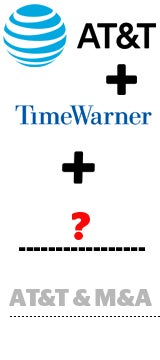Mazel tov, it’s a merger. On Tuesday, Judge Richard Leon gave his blessing to AT&T’s $85 billion acquisition of Time Warner.
The judgment capped five weeks of testimony, six weeks of deliberation and a fair amount of nail-biting in executive suites from Dallas to New York City.
But now that the deal is finally sealed, what does it mean for the M&A landscape?
Vertical integration FTW, said Phillip Fresen, managing director of investment bank Garros Group.
“While it does not open the door for other types of consolidation plays, deals in the media industry have occurred in waves, and we should expect more,” Fresen said.
Legacy companies, such as Comcast and Fox (or Fox and Disney, as the case may be), will be able to more easily combine forces and compete with a potent combination of content and distribution against the tech overlords in Silicon Valley.
The deal sets a precedent that can be leveraged by other companies, said LUMA Partners founder and CEO Terry Kawaja.
“It will raise the bar on necessary scale in media, which has already prompted other deals in order to compete with big tech,” Kawaja said, pointing to CBS and Viacom. “And when the digital CTV deals start, other deals will likely follow – there is currently over $300 billion in deals pending.”
The AT&T-Time Warner hookup also conceptually validates Comcast-NBCU, said Elgin Thompson, managing director of Digital Capital Advisors. It’s now not beyond the realm of possibility to see Apple snap up Disney or for a telco like Verizon or Sprint/T-Mobile to acquire a content player.
For AT&T specifically, the stage is set for a pedal-to-the-metal strategy centered on digital M&A.
“AT&T has spent $150 billion on traditional content and distribution through Time Warner and DirectTV,” Kawaja said. “They now need digital monetization and data capabilities to take advantage.”
With the question mark hanging over the deal transformed into an exclamation mark, the path is clear for AT&T to pursue ad tech opportunities.
“While the execution of the go-forward strategy is not a slam dunk, the new AT&T would have a seat at the table to acquire, create content and distribute it in this evolved ecosystem,” Thompson said.
And while AT&T revs up its strategy in one corner of the ring, other conversations that were on hold since the “DOJ pushed the pause button on the media M&A market” can start buzzing again, Thompson said.
But even though the cloud of uncertainty has lifted, there won’t a sudden mass consolidation.
“For the largest deals, you might see an immediate reopening, [and] for those in the middle market, the trickle-down may take a little time, but would not be a floodgate, either,” Thompson said. “You also have smaller studios like Lionsgate and MGM rumored to be for sale. Those deals could be unlocked.”















